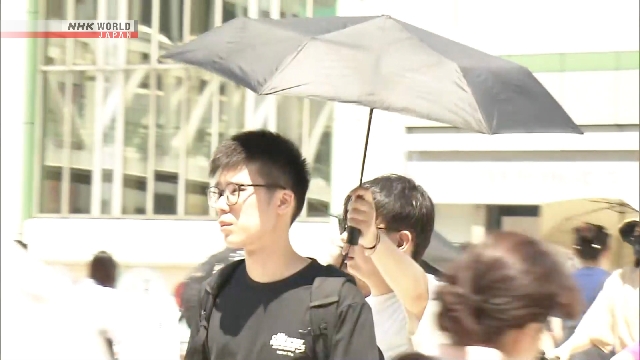Japanese weather officials say the country recorded its highest-ever temperature of 41.8 degrees Celsius on Tuesday in Isesaki City, north of Tokyo.
The Meteorological Agency says a high-pressure system covering mainly the Pacific coast of eastern through western Japan brought clear skies but also hazardous heat.
As of 2:30 p.m. temperatures of 40 degrees or higher were recorded at 12 observation points in the Kanto Koshin region, which includes Tokyo.
Isesaki City in Gunma Prefecture hit 41.8 degrees at 2:26 p.m., topping the previous record of 41.2 degrees, set just last Wednesday in Tamba City in the western prefecture of Hyogo.
Other highs include 41.2 degrees in Kiryu City and 41.0 degrees in Maebashi City, both in Gunma Prefecture. The temperature in Koga City, Ibaraki Prefecture, hit 40.6 degrees. Tokyo’s western city of Ome recorded 40.4 degrees.
It is the sixth time this summer that highs of 40 degrees or above have been observed in Japan.
Heatstroke alerts have been issued for 44 of Japan’s 47 prefectures.
People are being urged to avoid unnecessary outings and stay in cool environments as much as possible. They are also being urged to take in plenty of water and salts.
Meanwhile, a passing low-pressure system accompanied by a weather front is making atmospheric conditions unstable, mainly in the northern Japanese regions of Hokkaido and Tohoku. Rain clouds have been developing in these regions since before dawn on Tuesday.
Noshiro City in Akita Prefecture had 65 millimeters of rain in the hour through shortly past 4:30 a.m., and Kushiro City in Hokkaido had 60 millimeters in the hour through shortly before 8:00 a.m. Both were record amounts.
Localized downpours were expected throughout the day.
Some areas of Tohoku and Niigata Prefecture could get 120 millimeters of rain in the 24-hour period through Wednesday morning.
The rain is expected to continue in Tohoku, Niigata and the Hokuriku region through Thursday, as the front will remain stationary.
Caution is advised against flooding in low-lying areas, along with rising rivers, lightning, sudden wind gusts and hail.


AloJapan.com